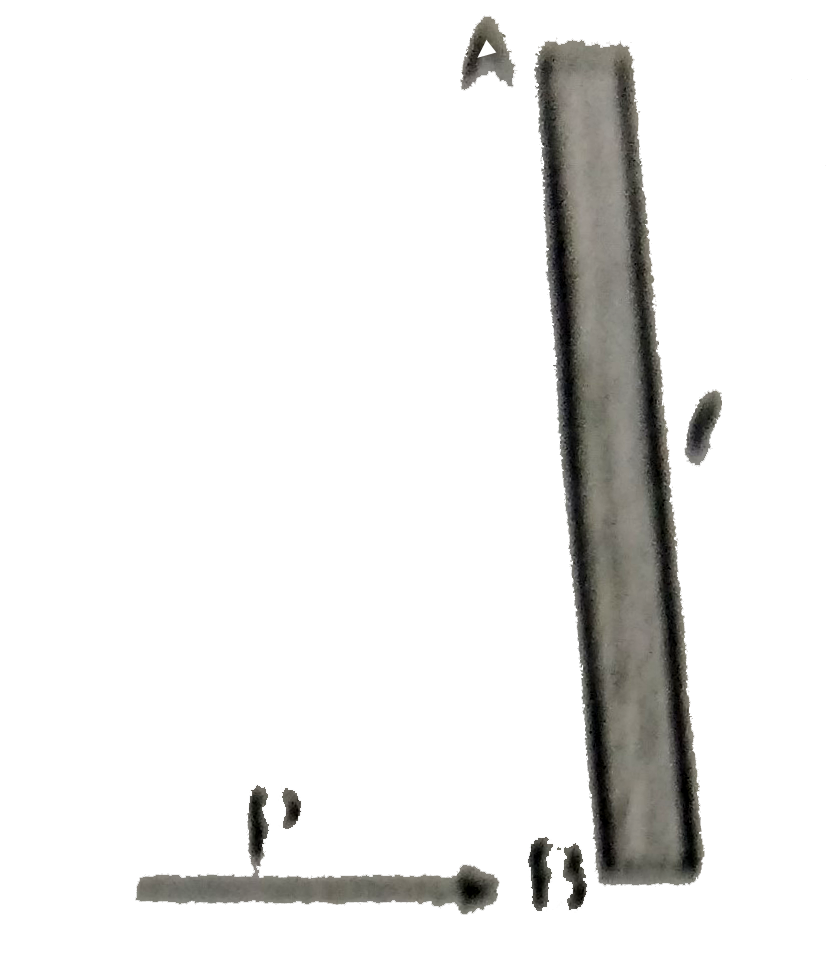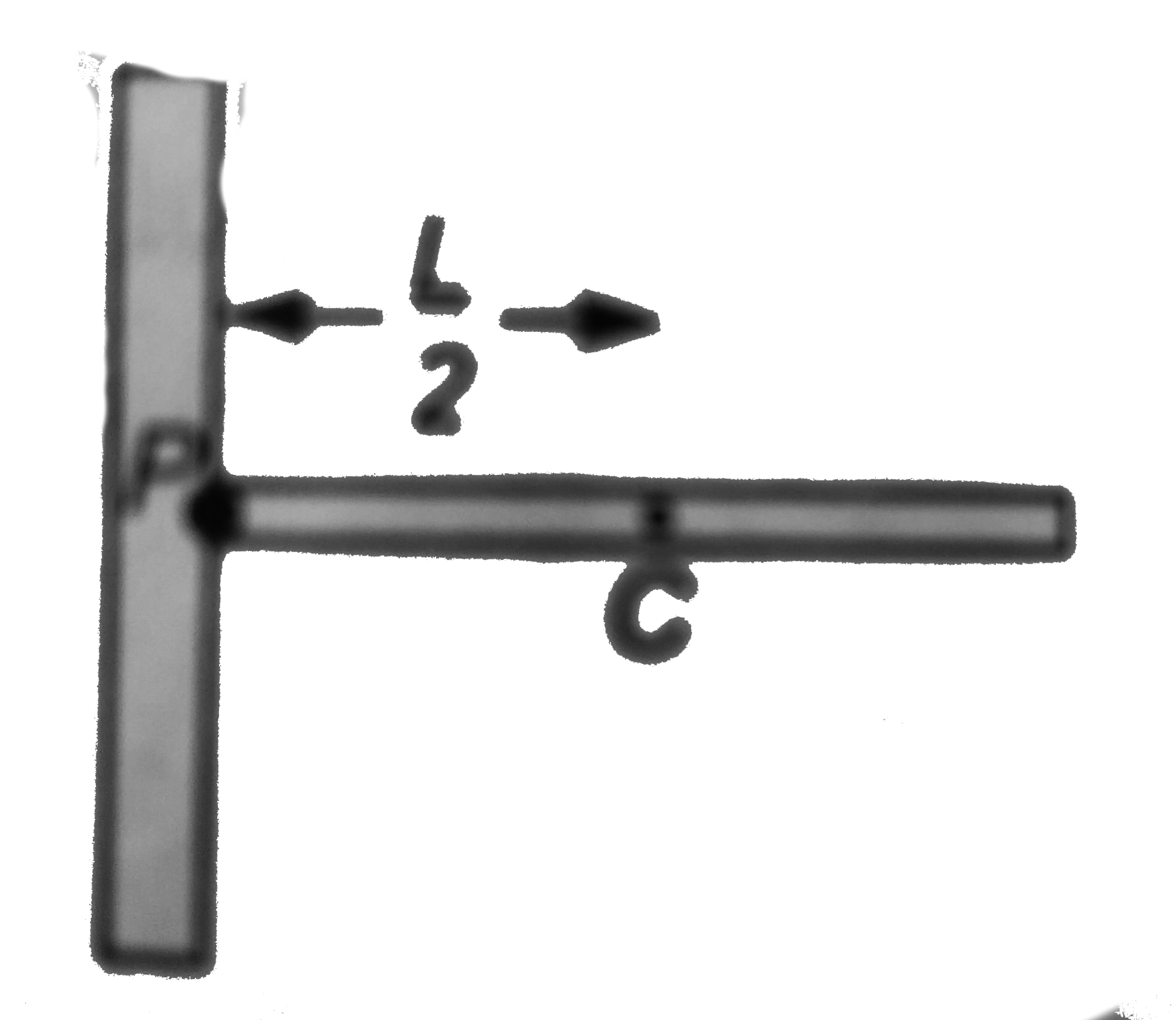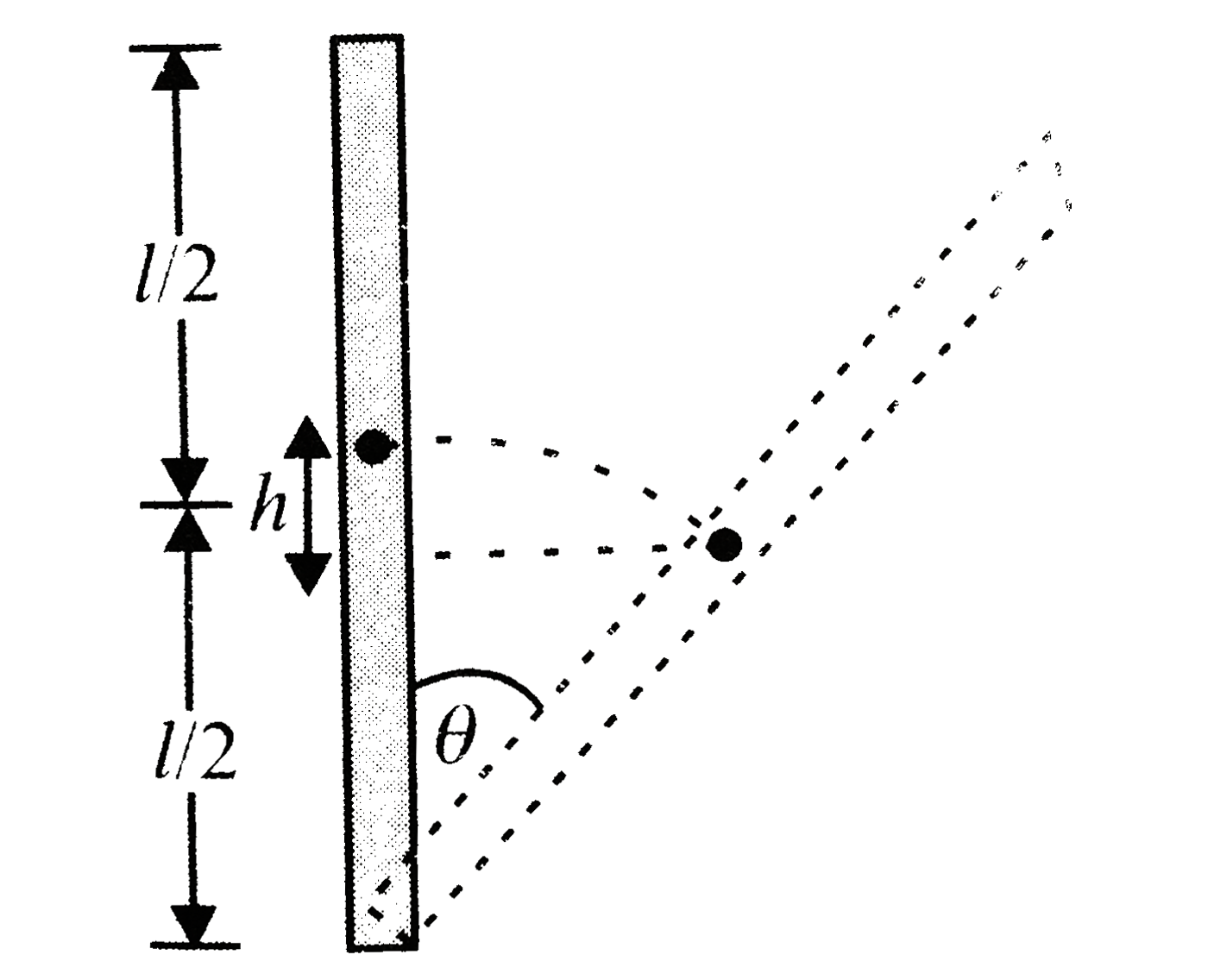A uniform rod of length L rests on a frictionless horizontal surface. The rod is pivoted about a fixed frictionless axis at one end. The rod is initially at rest. A bulled travelling parallel to the horizontal surface and perpendicular to the rod with speed v strikes the rod at its centre and becomes embedded in it. the mass of the bullet is one-sixth the mass of the rod.
(a). What is the final angular velocity of the rod?
(b). What is the ratio of the kinetic energy of the system after the collision to the kinetic energy of te bullet the o collision?
To solve the problem, we will break it down into two parts as requested:
Part (a): Finding the Final Angular Velocity of the Rod
1. Identify the system before and after the collision:
- Before the collision, the rod is at rest and the bullet is moving with velocity v.
- After the collision, the bullet embeds into the rod, and they rotate together about the pivot.
2. Apply the conservation of angular momentum:
- The initial angular momentum of the system (only the bullet contributes since the rod is at rest) is given by:
Linitial=mbullet⋅v⋅r
where r=L2 (the distance from the pivot to the center of the rod).
- The mass of the bullet is mbullet=m6 (where m is the mass of the rod).
Thus,
Linitial=m6⋅v⋅L2=mvL12
3. Calculate the moment of inertia of the system after the collision:
- The moment of inertia of the rod about one end is:
Irod=mL23
- The moment of inertia of the bullet (treated as a point mass at a distance L2) is:
Ibullet=m6⋅(L2)2=mL224
- Therefore, the total moment of inertia after the collision is:
Itotal=Irod+Ibullet=mL23+mL224
To combine these, find a common denominator (which is 24):
Itotal=8mL224+mL224=9mL224
4. Set the initial angular momentum equal to the final angular momentum:
Lfinal=Itotal⋅ω
Thus, we have:
mvL12=9mL224⋅ω
5. Solve for the angular velocity ω:
- Cancel m from both sides:
vL12=9L224⋅ω
- Rearranging gives:
ω=vL12⋅249L2=2v9L
Thus, the final angular velocity of the rod is:
ω=2v9L
Part (b): Ratio of Kinetic Energy of the System After Collision to Kinetic Energy of the Bullet Before Collision
1. Calculate the kinetic energy of the bullet before the collision:
KEbullet=12mbulletv2=12⋅m6⋅v2=mv212
2. Calculate the kinetic energy of the system after the collision:
- The kinetic energy of the system (rod + bullet) after the collision is:
KEsystem=12Itotalω2
Substituting Itotal and ω:
KEsystem=12⋅9mL224⋅(2v9L)2
Simplifying:
KEsystem=12⋅9mL224⋅4v281L2=9mL2⋅4v22⋅24⋅81L2=36mv23888=mv2108
3. Calculate the ratio of the kinetic energies:
Ratio=KEsystemKEbullet=mv2108mv212=12108=19
Thus, the ratio of the kinetic energy of the system after the collision to the kinetic energy of the bullet before the collision is:
Ratio=19
Final Answers:
(a) The final angular velocity of the rod is 2v9L.
(b) The ratio of the kinetic energy of the system after the collision to the kinetic energy of the bullet before the collision is 19.
- Before the collision, the rod is at rest and the bullet is moving with velocity v.
- After the collision, the bullet embeds into the rod, and they rotate together about the pivot.
- The initial angular momentum of the system (only the bullet contributes since the rod is at rest) is given by:
Linitial=mbullet⋅v⋅r
where r=L2 (the distance from the pivot to the center of the rod).
- The mass of the bullet is mbullet=m6 (where m is the mass of the rod).
Linitial=m6⋅v⋅L2=mvL12
- The moment of inertia of the rod about one end is:
Irod=mL23
- The moment of inertia of the bullet (treated as a point mass at a distance L2) is:
Ibullet=m6⋅(L2)2=mL224
- Therefore, the total moment of inertia after the collision is:
Itotal=Irod+Ibullet=mL23+mL224
Itotal=8mL224+mL224=9mL224
Lfinal=Itotal⋅ω
Thus, we have:
mvL12=9mL224⋅ω
- Cancel m from both sides:
vL12=9L224⋅ω
- Rearranging gives:
ω=vL12⋅249L2=2v9L
ω=2v9L
KEbullet=12mbulletv2=12⋅m6⋅v2=mv212
- The kinetic energy of the system (rod + bullet) after the collision is:
KEsystem=12Itotalω2
Substituting Itotal and ω:
KEsystem=12⋅9mL224⋅(2v9L)2
Simplifying:
KEsystem=12⋅9mL224⋅4v281L2=9mL2⋅4v22⋅24⋅81L2=36mv23888=mv2108
Ratio=KEsystemKEbullet=mv2108mv212=12108=19
Ratio=19
(a) The final angular velocity of the rod is 2v9L.
Topper's Solved these Questions
- BOOK - DC PANDEY ENGLISHCHAPTER - ROTATIONAL MECHANICSEXERCISE - Level 2 Single Correct26videos
ROTATIONAL MECHANICS
- BOOK - DC PANDEY ENGLISHCHAPTER - ROTATIONAL MECHANICSEXERCISE - Level 2 Multiple Correct36videos
ROTATIONAL MECHANICS
- BOOK - DC PANDEY ENGLISHCHAPTER - ROTATIONAL MECHANICSEXERCISE - Level 1 Objective30videos
ROTATIONAL MECHANICS
- BOOK - DC PANDEY ENGLISHCHAPTER - ROTATIONEXERCISE - (C) Chapter Exercises39videos
ROTATION
- BOOK - DC PANDEY ENGLISHCHAPTER - ROTATIONAL MOTIONEXERCISE - Integer Type Questions17videos
ROTATIONAL MOTION
Similar Questions
A slender rod of mass M and length L rests on a horizontal frictionless surface. The rod is pivoted about one of ends. The impulse of the force exerted on the rod by the pivot when the rod is struck by a blow of impulse J perpendicular to the rod at other end is
View SolutionA straight rod AB of mass M and length L is placed on a frictionless horizontal surface. A force having constant magnitude F and a fixed direction start acting at the end A. The rod is initially perpendicular to the force. The initial acceleration of end B is
View SolutionA uniform rod of mass M and length L lies flat on a frictionless horizantal surface. Two forces F and 2F are applied along the length of the rod as shown. The tension in the rod at point P is
 View Solution
View SolutionA uniform rod of mass m, length l rests on a smooth horizontal surface. Rod is given a sharp horizontal impulse p perpendicular to the rod at a distance l/4 from the centre. The angular velocity of the rod will be
View SolutionA uniform rod of mass M and length a lies on a smooth horizontal plane. A particle of mass m moving at a speed v perpendicular to the length of the rod strikes it at a distance a4 from the centre and stops after the collision. Find a. the velocity of the cente of the rod and b. the angular velocity of the rod abut its centre just after the collision.
View SolutionA uniform rod AB of mass m and length l at rest on a smooth horizontal surface . An impulse P is applied to the end B. The time taken by the rod to turn through a right angle is :
 View Solution
View SolutionA uniform rod AB of mass m and length l at rest on a smooth horizontal surface . An impulse P is applied to the end B. The time taken by the rod to turn through a right angle is :
 View Solution
View Solution
A uniform rod of length L and mass m is free to rotate about a frictionless pivot at one end as shown in figure. The rod is held at rest in the horizontal position and a coin of mass m is placed at the free end. Now the rod is released The reaction on the coin immediately after the rod starts falling isView SolutionA rod of length l is pivoted about a horizontal , frictionless pin through one end. The rod is released from ret in a vertical position. Find the velocity of the CM of the rod when the rod is inclined at an angle θ from the vertical.
 View Solution
View SolutionA uniform straight rod is placed in vertical position on a smooth horizontal surface and released. As the rod is in motion, the centre of mass moves
View Solution

